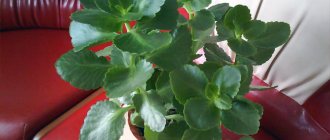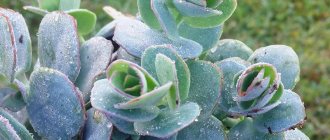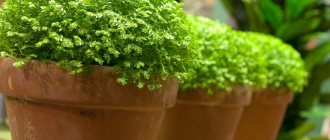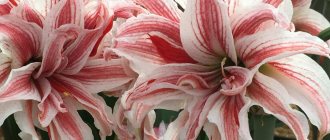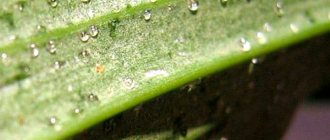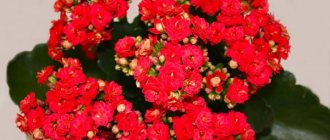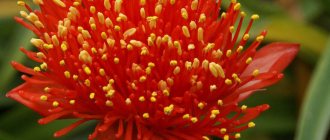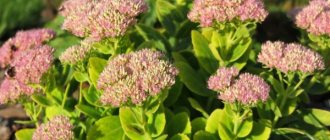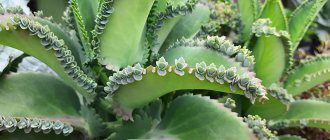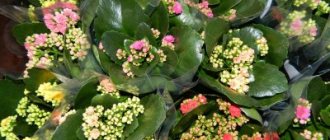Kalanchoe is a medicinal plant, unpretentious and easy to care for. It came to European latitudes from Africa and the Canary Islands. Tends to accumulate water, which contributes to survival in conditions of water deficiency. The stem can reach a height of more than one meter. Reproduces through leaves. It begins to bloom in winter with bright pink flowers. Kalanchoe does not like excess moisture, despite its tropical origin. It is watered so that the soil is moist, but not wet, and so that there is no water left in the pot.
Family doctor, or Kalanchoe doctor, as the flower is often called, is a very useful indoor plant. It does not require special care, and its benefits are more than enough.
What does it look like
What does medicinal Kalanchoe look like?
The most common indoor types:
- Kalanchoe Degremona. Reaches a height of 100 cm. It has triangular leaves, loves the sun;
- Kalanchoe Blossfeld. This species produces flowers. A more decorative variety than described above. The stem length is up to 30 cm. The leaves are round, the flowers are collected in a bunch. The variety prefers a shady place.
Degremona
Reproduction methods
The next point that would be good for owners of Kalanchoe Blossfeld to study is plant propagation. Over time, the Kalanchoe bush becomes outdated, and this means that it is time to update it. In principle, there is nothing complicated .
There are three ways to propagate this plant. The first is done using stem cuttings. To do this, take a young cutting, the length of which is approximately 7-12 cm. It is better to choose apical shoots. First you need to dry them (about two days), and then place them in water and wait until the roots grow.
For the second method, you will need leaves, which can be cut from the plant or simply used that have already fallen. Next, they are dried in the same way, and then placed in a container with water, which must be covered and placed in a bright place.
After you have chosen one of the methods and completed all the necessary steps, the Kalanchoe needs to be planted. For planting, soil that is designed specifically for indoor flowers is suitable. It is worth noting that it is better to take a container for this plant that is not very wide, otherwise it will simply grow without flowering. Make sure the soil is loose before planting. And it is very good if drainage is laid at the bottom of the pot.
The third method is seed propagation. Seeds are sown in rows. They can be lightly pressed, but not covered with soil. After this, the container used is covered with glass (you can also use transparent film) and placed in a well-lit area. This method is suitable for those who want to grow Kalanchoe from scratch.
As for replanting, it should be done in the spring, replacing the old soil with new one.
This time of year is a period of rest when Kalanchoe regains its strength. It should be remembered that young plants need to be replanted every year, adults - every 2-3 years.
Healing properties of Kalanchoe
Kalanchoe: home care and main family species
The plant has watery leaves rich in juice. They contain the active substances for which Kalanchoe is so valued. The juice is used for medicinal purposes. In particular, the leaves of the plant contain enzymes and organic acids, as well as flavonoids - special substances that affect the tone of the heart muscle.
Leaves of Kalanchoe Blossfeld
One leaf of the plant contains:
- vitamin C and P;
- tannins;
- flavonoids;
- mineral salts;
- a variety of macro and microelements (copper, manganese, calcium, aluminum, potassium);
- organic acids, etc.;
- polysaccharides;
- silicon;
- iron;
- magnesium.
These microelements promote healing, soothe irritation and inflammation. Thanks to them, burns, wounds and frostbite can be treated.
For your information! In ancient times, the Kalanchoe plant was used as a medicine by many peoples. The famous poet I. Goethe once wrote to his friends: “Starting with one leaf, the Kalanchoe grows many new shoots, so with one true love you can draw new happiness.”
Also, Kalanchoe medicinal purifies the air and disinfects. That is why it is useful to keep it in homes where allergy sufferers live. In addition, it fights the flu virus and other infections.
Kalanchoe is used in gynecology (during childbirth, during reconstructive operations). In dentistry, it helps cure putrefactive bleeding.
In cosmetology, its juice is used to remove dark circles under the eyes, heal minor wounds after operations, and cracks. For problem skin, rubbing a few drops of juice into irritated areas (acne, inflammation, eczema) helps.
Kalanchoe juice is used in many areas. In particular, in:
- surgery, including plastic surgery. From the juice of the plant, there is an acceleration of the regeneration of skin properties, cleansing wounds of pathogenic organisms, as well as a local anesthetic effect;
- ophthalmology. In this area, Kalanchoe is used for diseases of the cornea, keratitis, etc.;
- dentistry. This plant is good for treating stomatitis, gingivitis, periodontal diseases, etc.
Kalanchoe has the following properties:
- antiseptic;
- anti-inflammatory;
- healing;
- bactericidal.
For your information! If the flower is cared for correctly at home, the healing properties of its juice are preserved. If the flower lacked something or the plant was damaged, the properties become less pronounced.
Can Kalanchoe leaves be eaten fresh?
At first, people noticed the medicinal abilities of Kalanchoe and only then decided to try to use it for culinary purposes. The plant is rich in vitamins and minerals, so dishes made from it are really healthy, but since its leaves have a sharp, bitter taste, they are not widely used. Such dishes are more suitable for those who are interested in therapeutic nutrition, since they help restore the body after surgery or a debilitating illness, help cleanse the blood, protect against colds, and remove harmful substances.
Cucumber best reduces the astringency and bitterness of Kalanchoe, so in combination with it the medicinal plant is quite possible in a salad.
A good combination of Kalanchoe with carrots or avocado, green salad, fresh peas in olive oil dressing with lemon juice.
You can try making a vinaigrette with Kalanchoe. For it, as usual for such a dish, you will need to boil 3 potatoes, one beet and one carrot. Peel and chop the vegetables, add 2 chopped pickles and a handful of sauerkraut. Also chop pickled champignons (40 g), Kalanchoe leaves (30–40 g), and green onions. Salt, pour in sunflower oil - preferably unrefined, with the smell of seeds.
What does Kalanchoe treat?
Phalaenopsis orchid: main types and home care options
What Kalanchoe cures is a common question on the Internet. Here is a short list of diseases for which this representative of the flora helps:
- rhinitis;
- colds;
- inflammation of the mucous membrane of the nose and sinuses;
- healing of wounds and burns, the juice has restorative properties;
- bleeding;
- diseases of the digestive system.
Ointment
Treatment of runny nose and sinusitis
Be sure to look at what Kalanchoe for the common cold looks like in the photo. The Cirrus species is best suited for these purposes. During an illness, it is useful to drip the juice of the plant into the nose, and you can get it in the following way:
- Wash the leaves and chop them finely.
- Place the plate with the leaves in the refrigerator for several days, only then can they be put through a meat grinder and the juice extracted.
- The medicine needs to be renewed every two days.
For a slight runny nose, it is enough to wipe the nostrils with a cotton swab dipped in healing liquid. Children under two years old need to reduce the concentration of juice by diluting it with boiled water.
Dosage for sinusitis and common runny nose: three times a day, a couple of drops in each nostril.
In case of complications, it is permissible to consume the plant juice orally, but such treatment must be prescribed by a doctor. One large leaf or several small leaves yield up to 100 grams of juice. This amount is most often the daily dose. But before you start therapy, be sure to ask your doctor for a photo of Kalanchoe medicinal, so as not to be mistaken with the type of ingredient. You should not abuse the drink, as its excessive accumulation in the body can be toxic. The optimal dosage is no more than five grams per kilogram of human weight.
How to treat Kalanchoe for adults
Vanilla Orchid: main types and home care options
The Kalanchoe plant is actively used in folk medicine as a cure for many diseases. It can be compared to aloe, but the medicinal properties of Kalanchoe are the best way to combat viral diseases. The disease goes away much faster.
Based on Kalanchoe, the popular medicine Kalankhin was created, which is used in the treatment of gastroenteritis, burns, frostbite and cracked nipples of nursing mothers.
Possible difficulties during cultivation
Despite the unpretentiousness of the plant, some difficulties may arise during cultivation. Most often they are associated with a lack of flowering, pest attacks and the development of various diseases.
Why doesn't it bloom
Sometimes it happens that Kalanchoe Blossfeld does not bloom. The first thing to do in this case is to check the lighting level. If the plant is in a too shaded place, it needs to be moved to a brighter room or moved to a windowsill closer to the window. Another common cause is too much light. If, despite fulfilling all the requirements of the plant, the daylight hours last for more than 12 hours, it must be artificially reduced. You can either cover the flowerpot or move it to another room.
Diseases
Among the diseases that can affect Kalanchoe, the most common are those associated with excessive watering.
Excessive moisture causes:
- fungal infections;
- putrefactive lesions.
Before treatment, it is necessary to remove the affected areas. Next, you need to apply a systemic fungicide.
Pests
Kalanchoe Blossfeld rarely suffers from pests.
Nevertheless, cases of attacks by some of them periodically arise, including:
- aphid;
- mealybug.
Systemic insecticides are used to treat both. Another method of control is a soap solution, which is used to wash the foliage and shoots of the plant.
Kalanchoe Blossfeld is an unpretentious succulent that even beginner gardeners can start as their first plant. When properly maintained, the plant pleases its owners with long-lasting and beautiful flowering.
How to use Kalanchoe
The juice and leaves of the plant are used in different ways.
Kalanchoe for treating colds
To treat a runny nose, a decoction or juice of the leaves is used. Sometimes aloe and onion are added to it. In the latter case, it is very important to maintain the correct proportions.
Note! The therapeutic effect occurs when the nasal mucosa is slightly irritated, which leads to intense sneezing. In this way, a person gets rid of accumulated pathogenic mucus. For this reason, this plant is sometimes called "sneezer".
Before use, it is necessary to check whether a person is allergic to this plant. This is a very important point when using Kalanchoe juice. The plant can unnecessarily irritate the mucous membrane, thereby causing a deterioration in the patient's condition. But, if everything is done correctly and carefully, then a positive result is guaranteed. The mucus will come out of the sinuses, and the person will breathe easier.
Kalanchoe decoction
The uniqueness of the product lies in the fact that Kalanchoe officinalis is suitable for treating people of all ages.
You can get a medicinal decoction from Kalanchoe, for which you will need several leaves. They should be filled with 100 ml of water. Boil this mixture and cool completely. It is very important to use the decoction in small doses.
Plant juice
The easiest way is to simply squeeze the juice out of the leaves by squeezing them between your fingers. If the leaves are dry, they are first crushed and then carefully filtered through a bandage or gauze. You don't need a lot of juice, just 1-2 drops. For children under 2 years old, Kalanchoe juice is diluted with water. Sometimes you can even simply wipe the nasal cavity with a cotton swab dipped in juice.
Juice
Using nasal drops from Kalanchoe and aloe juice is very useful and effective. They are mixed in equal proportions in the amount of 1-2 drops of each plant. This medicine is the most gentle and gives a mild effect.
Important! If there is no allergy to Kalanchoe, the plant juice can be used as a preventative measure. During various epidemics, it is recommended to instill drops into the nose several times a day.
Growing conditions
Kalanchoe Blossfeld is a very unpretentious succulent. Nevertheless, its vital activity must be maintained by establishing the proper microclimate.
Placement and lighting
Immediately after purchase, the succulent is placed in a shaded place and gradually accustomed to exposure to bright light. After adaptation, the flowerpot should be placed in a well-lit place. You can choose a window sill as a permanent place, preferably located near an east or west window. It is also necessary to ensure that the green part is not exposed to direct rays of the sun. If necessary, the plant is slightly shaded.
When daylight hours become less than 12 hours, special lamps can be used. Artificial lighting will help the plant not to stop developing.
Important! If the light is too intense, burns may appear on the leaves.
Temperature
Kalanchoe Bossfeld is a heat-loving plant, but do not raise the temperature too much. In summer, the optimal temperature should be +24...+28°C, while it is better to set a constant heat level of +25°C.
In the winter season, the room temperature is reduced. Comfortable thermometer readings during this period for a succulent are +16…+18°C.
Air humidity
Since Kalanchoe Bossfeld is a succulent, it prefers dry air. The flowerpot does not need additional moisture in the form of spraying from a spray bottle or a light shower. They can only be used to clean the leaves of excess accumulated dirt.
Contraindications to the use of Kalanchoe
People with diseases of the liver, kidneys and joints should be more careful when treating Kalanchoe. There may be allergic reactions in nursing and pregnant women (during pregnancy it is generally advisable to refrain from treatment with this method).
Before use, it is better to consult a doctor, especially for people prone to allergies. Also, you should not use the plant juice for low blood pressure, tumors, or hepatitis.
Note! In its pure form, Kalanchoe is not suitable for children, because the child may have a burn to the nasal mucosa. It is best to test for allergic reactions before use to avoid unwanted effects.
All medications, even if they are natural, should be used after consultation with a doctor; this is a prerequisite for treatment.
Superstitions for women
The presence of Kalanchoe in the house promises happiness for women. It has a beneficial effect on the nervous system, general health, and reproductive organs.
- For an unmarried girl, the plant predicts a meeting with a worthy life partner. It will protect her from gossip and unwanted suitors;
- Soon she will have a marriage proposal and the birth of a child;
- For a married woman, it promises protection of the family hearth and preservation of the marriage for many years;
- For a family that has lived together for a long time, the plant will help bring back lost passion and strengthen their union.
The plant gives a good mood and brings harmony to the family. It can become a reliable talisman for all family members.
A plant in the house affects not only a good mood, but also the energy of the room as a whole.
Traditional medicine recipes
The leaves located as close as possible to the stem of the plant are best suited for preparing medicinal tinctures.
- Tincture. This is the first folk remedy. To prepare, you need to finely chop the leaves, pour vodka or alcohol into them, and leave them in a dark place for two weeks. Then the finished tincture should be stored in the refrigerator. Use for varicose veins, brittle nails, inflammation and wounds. You can rinse your mouth.
Drops
- Ointment. Mix fresh juice with Vaseline or fat. Mix thoroughly and keep in a water bath for half an hour. Store the resulting mixture in the refrigerator. It is a good remedy for treating wounds, inflammation, reducing swelling (such as varicose veins or dark circles under the eyes), and when used for cosmetic purposes. Useful for skin diseases, does not cause itching or burning.
- Fresh Juice. Used for ENT diseases; in the early stages, use a few drops 5 times a day. In this way, you can still treat warts and wounds by fixing the tampon on the problem area with a bandage.
For ear pain
The plant helps with many ailments. The following recipe will help people suffering from ear pain. The product will relieve severe pain. It is even used for moderate otitis media. You will need 2 tbsp. spoons of Kalanchoe juice and 200 g of 40% alcohol. Infuse for 10 days in the room. For treatment, 1-2 drops of tincture are instilled into the ear.
Using Kalanchoe for cosmetic purposes
In cosmetology, the houseplant Kalanchoe has healing properties and is primarily used to care for problem skin. At home, you can prepare a mask or balm from the juice of the plant.
Mask
First, you need to remove the skin from the leaves and lightly rub your face so that the medicinal juice is absorbed into it. After cleansing, apply nourishing cream. The toning effect will be noticeable after the first sessions.
This method can also be used to combat freckles or spots on the skin.
Important! It is worth remembering that the juice should not be applied to the area around the eyes, and it is better to cleanse before bed.
If we talk about Kalanchoe, there are a great many traditional medicine recipes.
- The juice treats stomach ulcers. To do this, you need to take 1 teaspoon three times a day for a month.
- If you have the flu, lubricate the nasal mucosa with juice three times a day.
- For ear pain, instill the juice 3-4 times a day, 1-2 drops.
- If eyelids become irritated, wipe 3-4 times a day.
- Rinse the mouth for various inflammations and gum diseases.
- For mastitis, apply compresses 2-3 times a day.
- The juice is used for kidney inflammation, tuberculosis, psoriasis, warts and even mental and physical fatigue.
Do not forget that the mechanism of action of herbal preparations has not yet been fully studied.
Note! If Kalanchoe tinctures are made at home, you need to store them in dark places at low temperatures. This way, the concentration of elements that give a therapeutic effect will be maximum, and every beneficial property of the juice will be preserved.
Kalanchoe and its varieties. Their appearance
Botanical characteristics
Kalanchoe is a native of the hot tropics, is unpretentious and lives in the wild even on rocky slopes. It has taken root well in the Russian climate as an indoor medicine.
What Kalanchoe looks like: the plant belongs to the genus of succulent plants. Their height ranges from a couple of tens of centimeters to four meters, and among them there are vines and epiphytes. Kalanchoe leaves are opposite, alternate, simple, toothed, lobed, entire or pinnately incised. Blooms in the second year of life. The inflorescence is tripartite, has the appearance of a panicle. The flowers are large, red, white, pink, yellow, greenish or purple. Propagated by cuttings, seeds and buds. The stems and leaves of Kalanchoe are used for medicinal purposes. The plant is included in tinctures, creams, and ointments.
Varieties used
There are about 200 species and varieties of plants that grow in America, Africa, and Australia. Most of them are used as ornamental plants, but there are exceptions of Kalanchoe - species that have enormous healing power. Among them are:
Kalanchoe dissected or pinnate - has the greatest healing ability and is widely used in official medicine and the pharmaceutical industry in the production of medicines. It grows up to 2 meters in height, has tree-like fleshy stems with glossy round leaves, on the teeth of which buds develop, ensuring the reproduction of the plant. Kalanchoe blooms in the cold season, forming large panicles on the stalks.
Kalanchoe Blossfeld is recognized by official medicine and uses its medicinal properties in the production of medicines. This species reaches 30 cm in height, has numerous stems, ovate leaves with a red edge. It blooms all winter, forming inflorescences in the form of brushes of dark red, pink or orange color.
Degremona - this species uses its medicinal properties in traditional medicine recipes. The plant reaches half a meter in height, has oblong green leaves, along the edges of which children are formed that can separate and take root in the ground. It blooms in winter, producing bell-shaped inflorescences of pink or purple color.
Laciniata - received the name “deer horns” for its bizarre and original appearance. The flower has carved branched leaves resembling fleshy spines.
Serrata - originally from Menorca, has an unusual color - spotted underneath. The leaves along the edges form rosettes of children, giving the flower a unique decorative effect.
Chemical composition
The plant contains a large number of biologically active components:
- Tannins;
- Vitamins;
- Organic acids;
- Minerals (manganese, zinc, aluminum, iron, magnesium);
- Enzymes;
- Steroid substances (bufadienolides);
- Flavonoids;
- Polysaccharides;
- Ascorbic acid:
Bryophyllum - medicinal properties
The plant has a wide range of medicinal effects on the body:
- Activates redox processes and hematopoiesis;
- Has an antimicrobial and astringent effect;
- Stops bleeding;
- Cleanses and renews blood, restores the circulatory system;
- Stimulates metabolic and metabolic processes;
- Normalizes digestion;
- Prevents fermentation and rotting in the intestines;
- Helps absorb calcium;
- Cleanses the blood and body from radionuclides, waste and toxins;
- Relieves inflammation and eliminates pain;
- Strengthens the immune system and the body's defenses;
- Accelerates the process of cell regeneration and helps heal wounds;
- Lowers cholesterol levels;
- Stimulates the formation and excretion of bile;
- Relieves physical and mental fatigue, has a tonic effect;
- Prevents rapid aging and fading.
KALANCHOE
Application of Kalanchoe
Kalanchoe in folk medicine is taken internally and used externally to treat the following diseases:
- Colds, flu, ARVI;
- Stomatitis, gingivitis, periodontal disease;
- Conjunctivitis and otitis;
- Cough, runny nose, sore throat, tonsillitis, adenoid;
- Gastritis and ulcers;
- Varicose veins;
- Tuberculosis;
- Adenomas, prostatitis;
- Acne and pustular inflammation;
- Joint diseases;
- Erosion and mastitis;
- Psoriasis, eczema, skin ulcers, burns, cuts, bedsores;
- Hemorrhoids:
How to store
The most convenient way to store it is to keep the flower on the windowsill, picking off fresh leaves if necessary.
Freshly squeezed juice is stored in the refrigerator for a week in a glass container.
Self-prepared ointment can be stored for no more than a month, and a ready-made infusion can be stored for 24 hours.
The alcohol tincture retains its healing properties for up to three months.
Kalanchoe: home care
To grow a miracle flower at home, it is important to take into account some rules.
Basic lighting requirements
Kalanchoe needs good lighting. From morning until two o'clock in the afternoon, you need to maintain bright light (for example, keep a flower on the windowsill). After lunch, there is no need for such intense lighting, so you can move the flower to a darker place. In winter, Kalanchoe needs more light, so the plant is best placed on a windowsill on the south side of the house.
Temperature
Kalanchoe itself feels best at 17-19 °C, but even if the temperature in the room drops to 5-6 °C, this will not affect the condition of the flower.
Important! What you definitely need to protect it from is heat. At high temperatures, it tries to absorb more moisture, which can cause various diseases or rotting.
How to water an indoor flower
As already mentioned, excess moisture is detrimental to the flower. It's best to just water it with cool water. When watering, you need to avoid getting water on the surface of the stems and leaves, this leads to their rotting. Water sparingly to keep the soil moist but not waterlogged.
The watering procedure should be repeated on average once a week. Use cool, settled water.
Due to the fact that the plant accumulates a lot of moisture in its leaves, it can easily tolerate short periods of drought. At the same time, Kalanchoe categorically does not tolerate high humidity. In winter and autumn, watering is carried out half as often.
Important! Dusty leaves should simply be wiped with a slightly damp cloth. It is also necessary to remove wilted inflorescences and diseased leaves that begin to curl, turn yellow and dry out, otherwise the flowers may begin to fall off.
Kalanchoe can be propagated. To do this, in May or June, the tops of the shoots are transplanted into a mixture of sand and clay. Young shoots that appear after removing old inflorescences are well suited for seedlings.
Kalanchoe medicinal flower is a very useful plant that will help with many diseases and their prevention. In addition, some of its species produce beautiful flowering and will be a good decoration for the home. Medicinal Kalanchoe, care for which at home is easy and simple, unpretentious. In response to care, the flower will purify the air in the room, and its juice will be rich in various microelements. What does Kalanchoe treat? Almost everything, this is its uniqueness.
Is Kalanchoe poisonous to cats?
Cats quite often try to chew on indoor plants, and not all inhabitants of a home windowsill are useful or at least harmless to them. For example, although Kalanchoe is considered a medicinal plant, it is dangerous for a cat, as it can seriously damage the pet’s health and even cause poisoning. It causes irritation of the gastrointestinal tract, resulting in vomiting and diarrhea. The juice of the plant can in some cases even provoke heart problems, including heart rhythm disturbances.
Video:
what flowers are dangerous for cats, dogs and other pets Expand
Benefits and medicinal properties
Kalanchoe is a medicinal plant because it has bactericidal, antioxidant, immunostimulating, regenerative, astringent (hemostatic), anti-inflammatory, choleretic, and healing properties.
- In particular, the leaves, stem and juice of this succulent of the Crassulaceae family are used as an internal or external remedy for the treatment of:
- acute respiratory diseases of a viral or bacterial nature (dropping into the nose or wiping its inner walls);
- festering wounds and tissue necrosis;
- burns;
- acne, boils, psoriasis and other skin problems;
- ulcers, including post-traumatic ones, and erosions;
- prostatitis;
- varicose veins;
- bleeding of various origins (external and internal);
- vitamin deficiency;
- some diseases of the organs of vision, in particular, blapharitis, conjunctivitis, glaucoma, destruction of the vitreous body of the eye, etc.;
- stomatitis, periodontal disease, gingivitis and other pathologies associated with gum inflammation.
The health benefits of Kalanchoe are also manifested in the plant’s ability to strengthen the walls of blood vessels, lower blood pressure, and also, thanks to the enzymes included in the succulent, accelerate metabolic processes in the body.
Did you know? It turns out that freshly cut green organs of Kalanchoe contain two times less useful substances than the same fragments that have lain for 7 days in a dark room at a temperature of +3...+6°C.
For medicinal purposes, juice or cut green parts of a succulent are usually used, however, even the very presence of a medicinal plant in the house can have a beneficial effect on the health of the people in it, since biologically active substances with antimicrobial effects are released by the flower during respiration and are concentrated in the air, purifying and disinfecting his.
